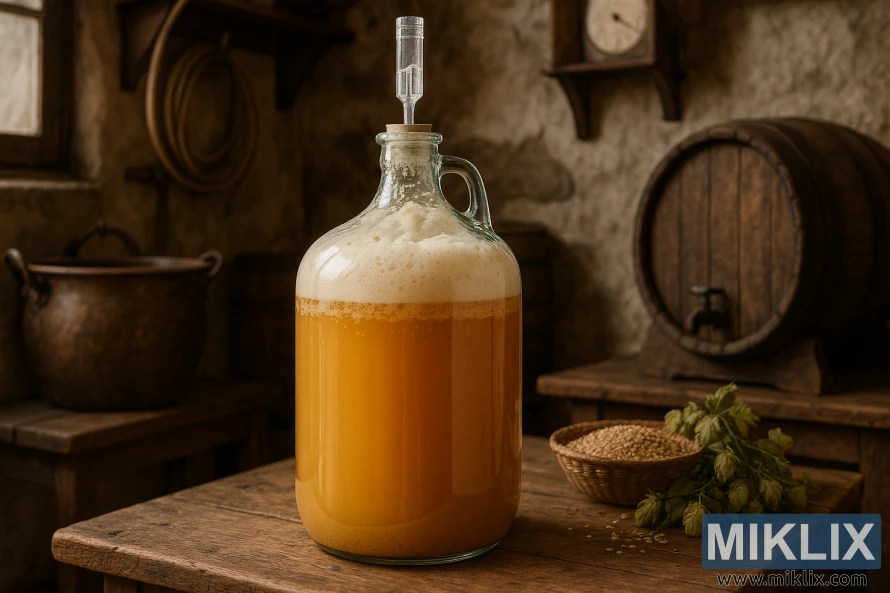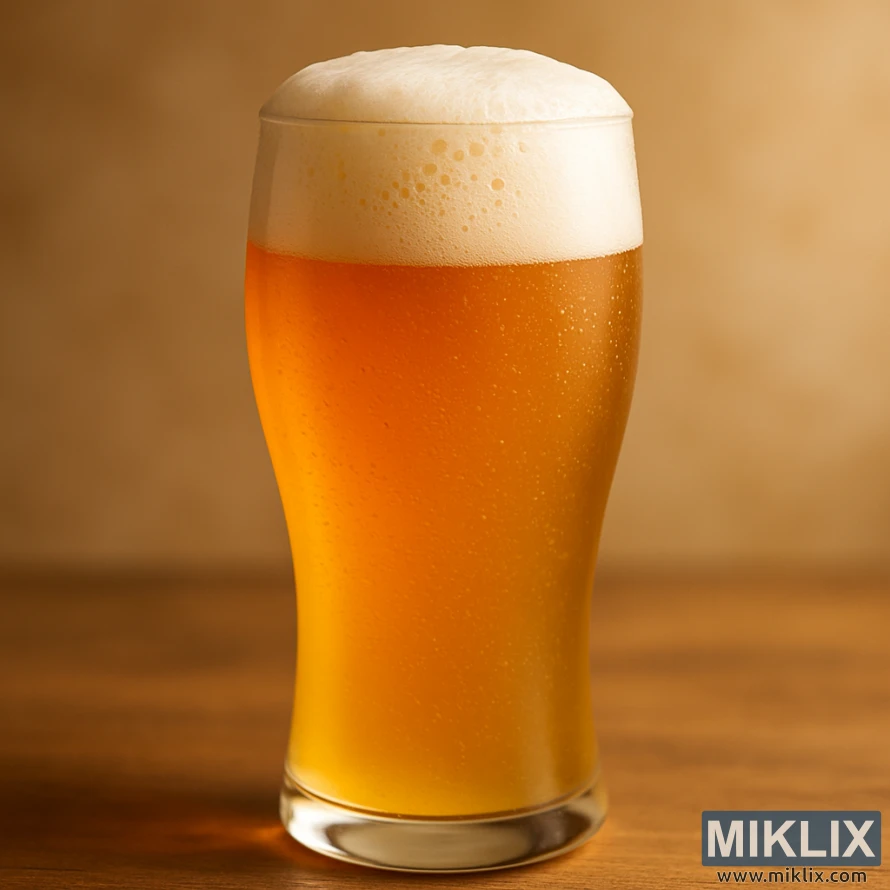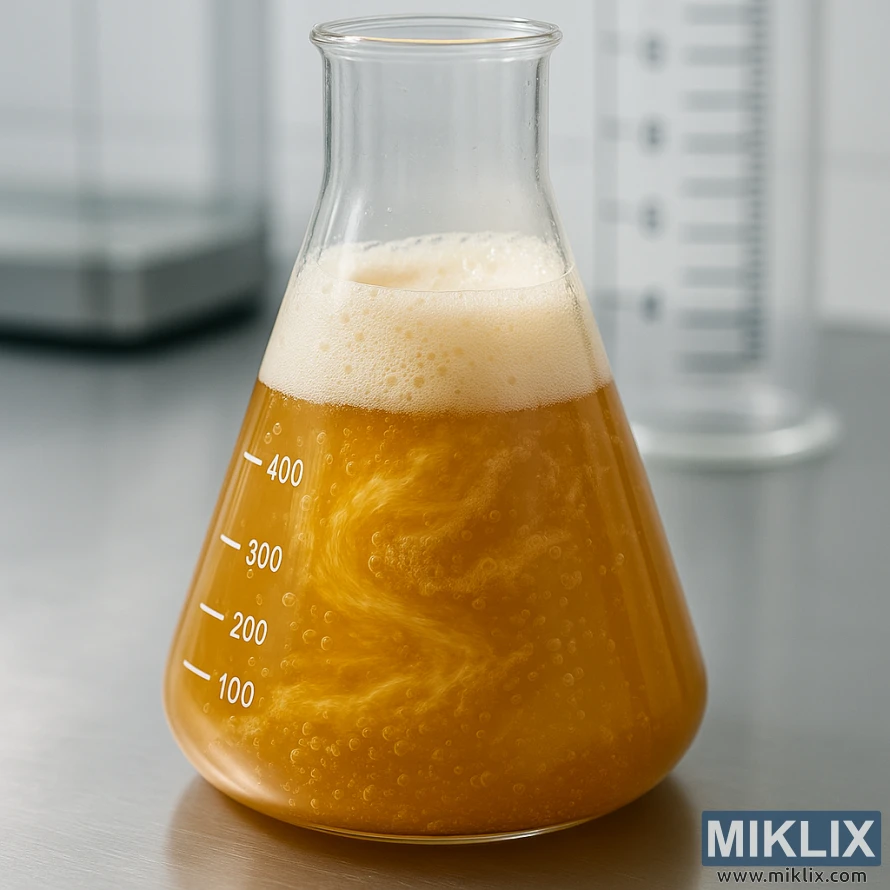Fermenting Beer with Lallemand LalBrew Munich Classic Yeast
Published: October 9, 2025 at 4:13:00 PM UTC
Lallemand LalBrew Munich Classic Yeast is a dry Bavarian wheat yeast strain. It comes from the Doemens Academy yeast bank in Germany and is distributed by Lallemand Brewing. This review aims to guide brewers through fermenting with LalBrew in Hefeweizen, Weissbier, Dunkelweizen, and Weizenbock recipes.

The strain is known for producing banana-like esters and clove phenol. It also has dependable attenuation, medium flocculation, and alcohol tolerance. You can expect practical details on fermentation temperature range, pitching rates, and top-cropping behavior. The focus is on real-world recipe compatibility.
This article is for professional and home brewers in the United States. It offers technical, flavor-driven advice for working with Bavarian wheat yeast. It balances sensory notes with process tips, helping you reproduce classic Hefeweizen yeast characters with a reliable dry option.
Key Takeaways
- Lallemand LalBrew Munich Classic Yeast is a Doemens-sourced dry strain suited for authentic Bavarian styles.
- The yeast delivers banana esters and clove phenols typical of Hefeweizen yeast when fermented in the proper range.
- Expect moderate flocculation and reliable attenuation for clear yet characterful wheat beers.
- The article provides pitching, temperature, and top-cropping guidance for practical brewery and homebrew use.
- Useful for brewers seeking a dry yeast alternative that preserves traditional Weissbier flavor profiles.
Why Lallemand LalBrew Munich Classic Yeast Is Popular for Wheat Beers
Brewers opt for LalBrew Munich Classic for its direct connection to traditional Bavarian wheat yeast performance. This strain was chosen to replicate the spicy clove and fruity banana aromas characteristic of Hefeweizen and Weissbier.
As a preferred Hefeweizen yeast, Munich Classic offers a consistent ester and phenol balance. This balance enhances the banana and clove notes, setting it apart from Belgian wheat alternatives. Brewers looking for a classic wheat flavor find its profile reliable across batches.
The yeast's popularity also comes from its versatility and simplicity. It suits Hefeweizen, Dunkelweizen, Weizenbock, and other wheat-centric recipes. It handles a variety of fermentation conditions well. Both small-scale and commercial brewers praise its consistent attenuation and robust flocculation.
Its top-fermenting nature aligns with traditional Bavarian methods. The strain can be skimmed off for top-cropping, appealing to brewers who adhere to historic practices. This characteristic solidifies the yeast's reputation for authenticity.
- Reliable aroma and flavor for wheat styles
- Flexible fermentation window for varied recipes
- Consistent performance that boosts Munich Classic popularity
Key Specifications and Technical Data of the Yeast
LalBrew Munich Classic specs are designed for simplicity, catering to both homebrewers and commercial brewers. It is a Saccharomyces cerevisiae, classified as a true top-fermenting ale yeast. This classification is crucial for understanding its role in wheat beer production.
The yeast's attenuation is medium to high, with values between 76–83%. This range ensures a balanced finish, retaining some body while allowing for a clean alcohol rise. It aids in predicting final gravity and guides recipe targeting.
Flocculation is low to weak, meaning the yeast stays suspended longer. This characteristic is beneficial for maintaining the classic Hefeweizen haze and ensuring flavors remain present during conditioning. Brewers should be aware of the slow yeast drop for quick clearing expectations.
Alcohol tolerance is approximately 12% ABV. This tolerance makes the strain suitable for stronger ales while still being ideal for typical wheat beer strengths. It's essential for planning extended or high-gravity ferments.
- Fermentation temperature range: manufacturer lists 17–25°C (63–77°F), with many sources recommending an ideal 17–22°C for balanced ester and phenol production.
- Pitch rate: recommended 50–100 g/hL for dry yeast packages; scale according to batch size.
- Top-cropping: true top-fermenting strain that can be skimmed in open fermentation systems.
- Product formats: available in retail sachets and bulk packs, including commercial 500 g options; pack size affects handling and price.
These LalBrew Munich Classic specs and S. cerevisiae data offer clear parameters for fermentation planning. Understanding yeast attenuation, flocculation, and alcohol tolerance allows brewers to set targets for flavor, haze, and strength without uncertainty.

Optimal Fermentation Temperature Range for Best Results
Begin your Munich Classic fermentation at around 17°C (62–63°F). This initial temperature is crucial for achieving a balanced flavor. It ensures the yeast produces the right amount of clove phenols and fruity esters.
For those aiming for a stronger clove presence, ferment between 16–19°C. To enhance banana notes, aim for 19–22°C. The ideal range for Lallemand LalBrew Munich Classic is 17–22°C.
Some technical sheets suggest temperatures up to 25°C are acceptable. Yet, higher temperatures can accelerate fermentation and increase ester production. This might result in an overly banana-flavored beer if not managed carefully.
- Begin cool at ~17°C to favor phenolic complexity.
- Gradually increase to ~19°C to coax esters without overpowering clove.
- Avoid prolonged fermentation above 22°C to prevent excessive banana esters.
Effective wheat beer temp control significantly impacts the final product. A controlled temperature increase during fermentation shortens the process. It also helps maintain a balance between phenols and esters.
Practical technique: start with a cooler, steady phase to limit harsh phenols. Then, allow a gentle increase to develop ripe fruit notes. This method ensures consistent results with Munich Classic yeast.
Flavor Outcomes: Balancing Banana Esters and Clove Phenols
Lallemand LalBrew Munich Classic offers a distinct Hefeweizen flavor, blending banana esters with clove phenols. Brewers find it crucial to manage this balance to achieve a true Bavarian character. This strain tends to express esters and phenols more intensely than many Belgian wheat strains.
Temperature is key in achieving this balance. Fermenting between 16–19°C enhances clove phenols. Raising the temperature to 19–22°C promotes banana esters. A practical method is to start at 17°C and then warm to 19°C during fermentation. This approach helps preserve spicy phenolics while encouraging fruity esters.
Recipe and process choices significantly impact the flavor. Factors like wort composition, original gravity, oxygenation, and pitching rate influence ester and phenol levels. Higher original gravity and lower oxygen levels can increase ester formation. Healthy yeast pitching and vigorous fermentation help suppress excess phenols.
Homebrewers experience varied results in achieving banana ester notes. Perception is influenced by mash profile, fermentation hygiene, conditioning, and individual sensitivity to aroma compounds. Some detect banana notes subtly, while others find them pronounced under the right conditions.
Serving conditions also impact the final taste. Conditioning time, carbonation level, and serving temperature affect the presentation of banana esters and clove phenols. Cooler serving and moderate carbonation can soften esters, while warmer pours emphasize phenolic spice.
- Start fermentation near 17°C, rise to 19°C to balance banana esters with clove phenols.
- Adjust pitching rate and oxygenation to favor or suppress esters.
- Tweak wort gravity and mash profile to support the desired Hefeweizen flavor.

Fermentation Performance and Speed with Munich Classic
Lallemand LalBrew Munich Classic exhibits impressive fermentation performance in homebrew and craft settings. With optimal oxygenation, healthy wort, and correct pitching, it can finish primary fermentation in just 48 hours. This fast fermentation requires close monitoring of gravity and temperature.
This yeast achieves robust attenuation, ranging from 76–83%, resulting in medium-to-dry final gravities. It's ideal for Hefeweizen and other wheat styles. Fermentation vigor is high at recommended temperatures. Warmer ferments enhance Munich Classic's fermentation speed and increase ester production, favoring banana esters.
Its low flocculation ensures cells remain suspended longer, supporting extended yeast activity. This characteristic haze is crucial for many wheat beers. Brewers aiming for clarity should plan for extra time or use fining agents after primary conditioning.
- Fast starts: vigorous krausen within 12–24 hours with proper pitch rates.
- Rapid finishes: some batches reach terminal gravity around 48–72 hours.
- Steady attenuation: expect medium-to-dry results consistent with style.
Practical considerations are key. Extremely rapid finishes often indicate ideal conditions. Brewers should verify final gravity before assuming fermentation is complete. Adequate conditioning is crucial to balance esters and phenols and allow CO2 and haze to settle.
Pitching Rates and Yeast Management Best Practices
Follow the Lallemand recommendation for a pitch rate of 50-100 g/hL when using LalBrew Munich Classic. Scale this range to fit your batch size. For a 5-gallon (19 L) homebrew, convert grams per hectoliter to grams needed for the batch. Accurate measurement ensures predictable fermentation.
Choose between direct pitching and dry yeast rehydration based on your workflow. Dry yeast rehydration can enhance cell viability, ideal for long storage or marginal wort conditions. Rehydrate in clean, sanitized water at the yeast maker’s suggested temperature. Then, temper to wort temperature to avoid thermal shock.
Effective yeast management begins with proper oxygenation. Provide adequate oxygen at pitch to support biomass growth and a healthy fermentation start. For higher original gravities, plan yeast nutrient additions and consider stepping oxygen levels to meet gravity and cell count needs.
Match yeast and wort temperatures to limit unwanted phenols and esters. Munich Classic responds well to a controlled start near 17°C for balanced ester and phenol profiles. If rehydrating, bring the yeast close to wort temperature or acclimate slowly to avoid stress.
- Monitor krausen formation and early gravity drop to assess yeast health.
- For lagging fermentations, check oxygen, nutrients, and temperature rather than simply adding more yeast.
- Document temperature and timing to refine future pitches.
Munich Classic tends to flocculate weakly, so plan conditioning time and cold breaks for clearer beer. Use filtration or fining agents if rapid clarification is needed for kegging or packaging. Gentle rousing before packaging can help yield a brighter final product.
Keep records of pitch rate, dry yeast rehydration steps, and any nutrient or oxygen adjustments. Consistent yeast management will reduce batch-to-batch variation. This helps you dial in the classic wheat profile you want from Lallemand LalBrew Munich Classic.

Packaging Considerations and Conditioning for Wheat Styles
Low flocculation in Lallemand LalBrew Munich Classic means yeast stays in suspension longer. Plan extra time for Munich Classic conditioning so flavors round out and yeast can settle if clarity is desired.
Packagers should confirm full attenuation before moving to packaging for Hefeweizen. Sealing too early can trap esters and phenols before they integrate into the beer. Monitor final gravity and allow a short stabilization period to avoid green or harsh notes.
Carbonation level changes perception of aroma and mouthfeel. Traditional Hefeweizen benefits from higher carbonation to lift banana esters and clove phenols. Target 3.5–4.5 volumes CO2 and adjust cell counts if you rely on bottle conditioning wheat beer for natural carbonation.
- For bottle runs, test viability. If yeast counts are low, add a neutral conditioning strain to ensure reliable carbonation during bottle conditioning wheat beer.
- When using open fermentation and top-cropping, harvest healthy Munich Classic slurry for reuse. That supports consistent Munich Classic conditioning across batches.
Some styles need clarity. Dunkelweizen and Weizenbock may call for cold conditioning, fining agents, or filtration. Expect a drop in classic haze and slight loss in mouthfeel when removing suspended yeast for a clearer pour.
Packaging format affects presentation. Kegs preserve aromas and make pouring easier for unfiltered hefe styles. Bottles allow retail distribution and enable bottle conditioning wheat beer, which can deepen complexity over weeks when done with proper yeast management.
Set a clear timeline: full fermentation, short bulk conditioning to marry esters and phenols, and measured carbonation tailored to the style. That approach protects delicate flavors while giving brewers control over final clarity and effervescence.
Compatibility with Adjuncts and Recipe Variations
Lallemand LalBrew Munich Classic is highly compatible with Munich Classic recipes. It excels in classic Bavarian wheat beers and richer variants. Its ester and phenol profile is ideal for traditional hefeweizen grists or darker styles.
When selecting adjuncts for wheat beer, choose them with purpose. Light fruit additions like orange peel or cherry enhance banana esters. Cloves from phenolic expression remain evident. Darker malts for Dunkelweizen or Weizenbock mute esters, revealing a spicier, fuller finish.
High-gravity projects require careful planning. Weizenbock yeast compatibility extends up to about 12% ABV. This allows brewers to increase strength with proper oxygenation, pitch rate, and yeast nutrients. Step-feeding or oxygenating well at pitch reduces stress, maintaining ester/phenol balance.
The mash profile significantly impacts body and fermentability. A higher mash temperature retains more dextrins, enhancing mouthfeel. This complements Munich Classic’s spice. A lower mash temperature increases fermentability, allowing the yeast to attenuate more and showcase esters.
- Use pilsner and wheat malt bases for classic hefeweizen.
- Add darker Munich or carahell in small amounts for Dunkelweizen character.
- Include fruit or spice adjuncts late in boil or at conditioning to preserve volatile esters.
Experimentation is key. This strain produces pronounced esters and phenols, making it suitable for hybrids. It adds a fruity, spicy yeast character. Test small batches to fine-tune Munich Classic recipe compatibility with your chosen adjuncts and desired Weizenbock yeast traits.
Comparing Munich Classic to Other Wheat Beer Strains
Munich Classic is a standout in wheat yeast comparisons, known for its bold ester and phenol profile. It offers more pronounced banana and clove notes compared to LalBrew Wit and many Belgian wheat strains. This makes it a favorite for brewers seeking a more expressive flavor.
Fermentation behavior varies among strains. Munich Classic produces both banana esters and clove phenols when temperature is managed correctly. In contrast, LalBrew Wit tends towards softer, more subtle aromas, ideal for Belgian-style witbiers. This distinction is crucial when selecting S. cerevisiae wheat strains.
Flocculation and haze are also important for style. Munich Classic's low flocculation helps maintain the classic Hefeweizen haze. Other strains, which flocculate more, can clear faster, making them suitable for clearer wheat ales or specific commercial recipes.
- Flavor focus: Munich Classic delivers stronger yeast character for German styles.
- Clarity: Other wheat strains can produce quicker clarification for a cleaner look.
- Temperature sensitivity: Ester/phenol balance shifts with fermentation control.
Usage niche guides selection. Choose Munich Classic for authentic Bavarian character and a pronounced yeast-driven profile. Opt for LalBrew Wit or other S. cerevisiae wheat strains when you want milder yeast contributions or a Belgian-leaning aroma.
Practical brewing tip: match yeast choice to recipe intent. For traditional Weissbier, pick Munich Classic. For lighter, spice-forward witbiers, pick LalBrew Wit. Clear goals simplify wheat yeast comparisons, leading to repeatable results.
Practical Troubleshooting and Common Issues
When you encounter issues with Munich Classic, begin with basic checks. Ensure the fermentation temperature, pitch rate, oxygenation, and sanitation are correct. These steps can resolve many wheat beer fermentation problems early on.
Low banana ester production often stems from cool fermentation temperatures or insufficient pitch rates. To address this, slightly increase the fermentation temperature within the yeast's optimal range. Also, confirm that you've pitched enough yeast cells and that the wort was properly oxygenated at the start.
Excessive clove or phenolic spice can result from fermenting too cool or from mash conditions that increase phenolic precursors. A slight temperature increase and adjusting the mash schedule can help reduce spicy notes. It's also important to note that malt and maltster differences can affect phenol levels.
Fast fermentation finishes are common with this strain. If fermentation appears complete in 48–72 hours, wait a few more days to check the final gravity before packaging. Premature bottling or kegging can lead to over-carbonation or off-flavors.
Haze and clarity issues often stem from low flocculation. Cold conditioning, extended lagering, or finings can clarify most beers if clarity is desired. Many wheat styles, though, accept or even expect haze, so consider whether clarity is a style or personal preference.
- Stalled fermentation: review pitch rate (50–100 g/hL guidance), rehydrate yeast properly, and provide nutrients.
- Sluggish activity: check oxygen levels and fermentation temperature profile.
- Off-flavors: confirm sanitation and avoid oxygen pickup after primary fermentation.
Common yeast issues can often be prevented with planned steps. Keep starter or pitch calculations current, monitor gravity daily early on, and adjust temps gently. Small corrections during active fermentation can save time and protect the final beer.
When wheat beer fermentation problems persist, document conditions and compare notes with suppliers like Lallemand or homebrew forums. Data on mash profile, oxygenation method, pitch rate, and exact temps speeds diagnosis and helps replicate successes.

Sustainability and Reuse: Top-Cropping and Yeast Harvesting
Munich Classic top-cropping is ideal for brewers who prefer open fermentation. This strain floats near the surface. This makes it easy to skim off healthy yeast without disturbing the beer below.
When harvesting wheat yeast from the foam, maintaining cleanliness is crucial. Use sanitized tools and hands. Store the slurry in chilled, sanitized jars. This method helps preserve the yeast's aroma and reduces contamination risks.
Decide whether to reuse yeast right away or store it. Short-term reuse typically involves repitching within a few generations. It's important to track generations and check cell viability to avoid off-flavors from stressed cultures.
- Wash the slurry gently to remove trub when planning longer storage.
- Keep the harvested yeast refrigerated and pitch within recommended windows.
- Label batches with date, strain, and generation count.
Yeast propagation can rescue small harvests or boost cell counts for larger brews. Start with fresh wort, monitor the krausen, and oxygenate early. This supports healthy growth and maintains vitality before reuse.
To reuse yeast responsibly, limit generations and run periodic viability tests. Low-flocculation strains may stay suspended, making harvest easier but requiring more care to avoid contamination.
Sustainable reuse saves money and reduces waste from single-use packs. Consistent harvesting practices also help preserve the unique house character that Munich Classic brings to wheat beers.
Buying Options, Packaging Sizes, and Cost Considerations
Lallemand offers LalBrew Munich Classic in various sizes. Homebrewers can find it in small sachets, while breweries can purchase bulk quantities. The retail packs are ideal for single batches, whereas the 500g yeast pack is perfect for frequent brewers or large production runs.
The cost of Munich Classic varies based on the seller and the size of the pack. Prices at local homebrew shops can differ from those found online. For instance, bulk 500g yeast packs often have a lower cost per batch. Some vendors list prices around $233.81 per 500g before tax.
Choosing whether to buy LalBrew Munich Classic depends on how often you brew and the size of your batches. Dry yeast formats offer advantages in storage and handling compared to liquid strains. For those who brew occasionally, single sachets are a cost-effective option. On the other hand, a 500g yeast pack is more economical for regular brewers.
- Pitch rate guide: 50–100 g/hL helps estimate yeast needed for your batch.
- Cost per brew falls as batch count rises when using bulk packs.
- Dry yeast formats ease inventory and reduce shipping weight compared with liquids.
Authorized Lallemand distributors, homebrew stores, and commercial suppliers in the United States carry this strain. Purchasing from reputable resellers ensures freshness and access to technical support from the manufacturer.
The value of Munich Classic lies in its consistent fermentation, easy top-cropping, and authenticity for Bavarian wheat styles. For brewers planning multiple batches, the pricing becomes more favorable when spread over several brews.
Advanced Techniques to Shape Ester and Phenol Expression
Temperature ramping offers direct control over yeast metabolism. Start fermentation near 17°C, maintaining this temperature during the lag phase. Once fermentation is active, increase the temperature to about 19°C. This step is crucial for achieving a balanced banana-to-clove flavor profile. It ensures that esters and phenols are controlled while fermentation remains vigorous.
The pitching rate significantly impacts ester formation. Aiming for 50–100 g/hL is a good starting point. Lower rates can enhance ester production. For cleaner flavors, slightly increase the rate when brewing higher gravity batches. Monitoring gravity and krausen is essential to ensure yeast health and adjust rates as needed.
Aeration at pitch is vital for healthy cell growth and consistent attenuation. Providing measured oxygen at the start is crucial. Avoid reoxygenation later to prevent yeast growth at the expense of flavor. Over-oxygenation can stress yeast, leading to off-notes. Proper oxygen management is key to controlling esters and phenols.
The mash schedule and wort composition greatly influence yeast character. Lowering the mash temperature increases fermentability and reduces body, enhancing ester notes. Raising the mash temperature leaves more dextrins, resulting in a fuller mouthfeel and muted esters. Adjusting the grain bill and simple adjuncts fine-tunes the interaction between fermentation techniques and yeast expression.
Nutrient strategy is crucial for cleanliness and control. Add yeast nutrients in high-gravity or adjunct-heavy recipes to prevent stress. Healthy yeast are less likely to produce fusels or unwanted phenolics. Thoughtful nutrient use enables predictable shaping of Hefeweizen flavor.
Conditioning time is essential for flavor integration and mellowing. After primary attenuation, allow cold conditioning or gentle aging. Extended maturation can soften sharp esters or intense phenols while preserving desirable character. Monitor samples and bottle when the profile matches your target.
- Temperature ramp: 17°C hold, then rise to ~19°C.
- Pitching guidance: 50–100 g/hL, adjust by style goals.
- Aeration: controlled oxygen at pitch only.
- Mash: lower temp = more fermentable wort; higher temp = more body.
- Nutrients: use for high-gravity or adjunct-heavy worts.
- Conditioning: allow time post-attenuation for integration.
Implement these fermentation management techniques in a coordinated manner. Small, strategic changes allow for precise control over esters and phenols. This approach ensures consistent and reliable shaping of Hefeweizen flavor across batches.
Conclusion
Lallemand LalBrew Munich Classic Yeast conclusion: This Saccharomyces cerevisiae strain, from the Doemens collection, is known for its banana esters and clove phenols. These characteristics are quintessential for Bavarian wheat beers. It has a medium-to-high attenuation of 76–83%, low flocculation, and can tolerate up to 12% ABV. It's ideal for Hefeweizen, Weissbier, Dunkelweizen, and Weizenbock.
Munich Classic summary: Brewers will find robust, consistent fermentation and top-cropping capabilities with this yeast. For optimal results, pitch at the recommended rate of 50–100 g/hL. Manage fermentation temperatures, starting near 17°C and allowing a slight rise to 19°C. This will help balance ester and phenol levels. Under ideal conditions, fermentation can finish in 48 hours.
Practical recommendation and final note: Munich Classic is a top choice for authentic Bavarian character. Plan for conditioning, packaging, and yeast handling to preserve delicate aromas. Quick fermentation is a key benefit. With careful temperature and pitching management, this strain consistently delivers the fruity, spicy flavors brewers desire.
Further Reading
If you enjoyed this post, you may also like these suggestions:
- Fermenting Beer with White Labs WLP850 Copenhagen Lager Yeast
- Fermenting Beer with Mangrove Jack's M54 Californian Lager Yeast
- Fermenting Beer with Bulldog B5 American West Yeast
